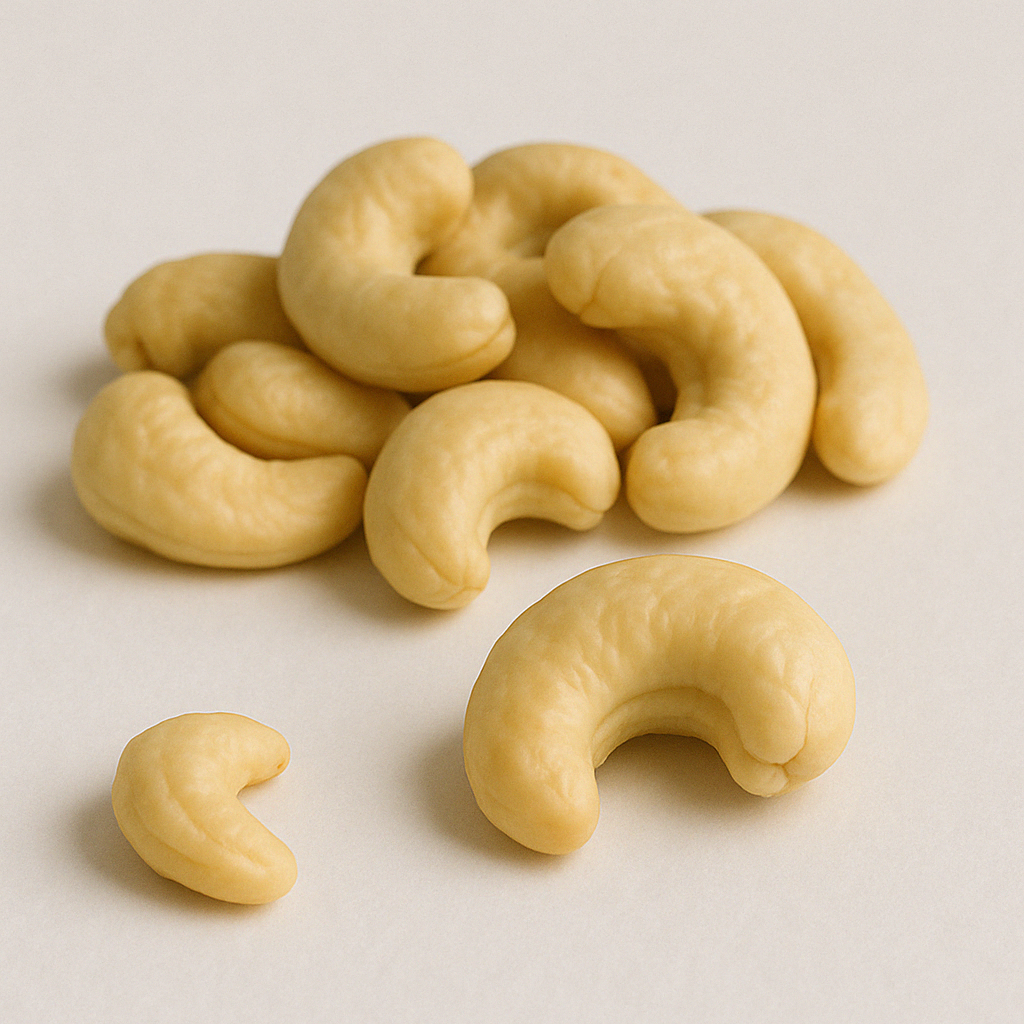
Cashew Nut from Nigeria
Featured manufacturers
/132x132/company-logo/dd/9a/bc/dd9abc7ec7d0c61d30cc71f17a94bcd0ffe47c65/black_rose_logo.jpg)
/132x132/company-logo/e8/44/ec/e844ec1db1d80cf7c262e4ffa3d38d103108dfce/photo_2025-05-08_09-57-42.jpg)
/132x132/company-logo/a5/88/1c/a5881c6087ac2b04631f9b9bd986d573003f768b/MERXIA_GLOBAL_LOGO_High_Contrast_200x74.png)
About this market
About
History
Cashew was introduced to Nigeria in the 1950s through afforestation and land rehabilitation projects. By the 1990s, exports began increasing significantly as international buyers recognized the country’s production potential. The Nigerian Export Promotion Council (NEPC) and National Cashew Association of Nigeria (NCAN) have since played a central role in sector coordination. Despite challenges like logistics and inconsistent quality, cashew has evolved into one of Nigeria’s top non-oil agricultural exports.
Production Regions
Cashew cultivation spans across Nigeria’s central and southern zones:
- Kogi State: Nigeria’s largest cashew-producing state; hub for aggregation and export.
- Oyo & Ogun States: Major producers in the southwest.
- Nasarawa, Benue & Kwara States: Central Nigeria; key cashew belts.
- Enugu & Ebonyi States: Southeastern regions with expanding smallholder output.
Growing Conditions
Nigeria offers favorable conditions for cashew trees:
- Climate: Tropical wet and dry; distinct rainy and dry seasons.
- Temperature: Optimal between 25–35°C.
- Rainfall: 1,000–1,200 mm annually.
- Soil: Sandy to lateritic loam, well-drained, slightly acidic to neutral pH.
- Altitude: Grown up to 700 meters above sea level.
Harvesting Process
Harvesting is done manually once the nuts drop from the trees:
- Indicators: Cashew apples turn reddish or yellow; nuts fall freely.
- Drying: Sun-dried for 2–4 days to lower moisture to acceptable levels.
- Sorting & Bagging: Cleaned, handpicked for defects, and bagged in 80 kg jute sacks.
Cultivation Method
Cashew is cultivated mainly by smallholders with 1–5 hectares:
- Planting: 8x8 m spacing with hybrid seedlings gaining popularity.
- Weeding & Pruning: Manual clearing and canopy management to boost yields.
- Fertilization: Limited input use; some NPK and organic practices.
- Pest Control: Use of IPM to manage fruit borers and fungal infections.
Supply Chain
Nigeria’s cashew supply chain is complex but increasingly organized:
- Producers: Over 300,000 smallholder farmers contribute to production.
- Aggregators & Agents: Link farmers to local traders or exporters.
- Exporters: Handle grading, storage, and shipment to Asia.
- Processors: Emerging processors in Ogun, Kwara, and Kogi states; still a small share of total production.
Local Logistics
- Collection Points: Rural buying centers or designated cashew hubs.
- Transport: Road transport to Lagos ports or inland dry ports.
- Warehousing: Jute-bagged storage in ventilated warehouses to maintain quality.
- Export Ports: Lagos (Apapa & Tin Can Island): Main gateway for cashew exports. Calabar & Port Harcourt: Used occasionally for southeastern sourcing.
Regulations and Certifications
- Export Registration: Via NEPC and Customs for licensed exporters.
- Phytosanitary Compliance: Enforced by Nigeria Agricultural Quarantine Service (NAQS).
- Certifications: Organic and Fairtrade for niche buyers. Increasing interest in traceability and quality control systems.
Quality Standards
Export-quality Nigerian RCNs meet key international benchmarks:
- Nut Count: 170–190 per kg.
- Moisture Content: Below 10% for export.
- Out-turn Ratio (OTR): 47–50 lbs per 80 kg bag.
- Defects: Must be free of infestation, mold, and stones.
Trade Terms
- MOQ: Typically 10–25 MT for container shipments.
- Incoterms: FOB (Lagos), CIF (Nhava Sheva, Ho Chi Minh).
- Payment: Advance payment, LC, or CAD depending on buyer profile.
Environmental and Social Impacts
Cashew is environmentally and socially significant in Nigeria:
- Climate Resilience: Grows well in semi-arid conditions with limited water needs.
- Rural Development: Supports livelihoods across farming communities.
- Women’s Participation: Active in sorting, drying, and kernel processing.
- Challenges: Market access, price volatility, and lack of farmer extension services.
Uses
Cashew nuts are utilized across multiple segments:
- RCNs: Exported for kernel processing.
- Kernels: Used in snacks, cereals, vegan products, and baking.
- By-products: Cashew apple for juice or ethanol; shells for CNSL in industrial use.
Export of Cashew Nut from Nigeria
Export overview
Export trend
Verified manufacturers
/132x132/company-logo/dd/9a/bc/dd9abc7ec7d0c61d30cc71f17a94bcd0ffe47c65/black_rose_logo.jpg)
/132x132/company-logo/e8/44/ec/e844ec1db1d80cf7c262e4ffa3d38d103108dfce/photo_2025-05-08_09-57-42.jpg)
/132x132/company-logo/a5/88/1c/a5881c6087ac2b04631f9b9bd986d573003f768b/MERXIA_GLOBAL_LOGO_High_Contrast_200x74.png)
/132x132/company-logo/f1/a9/84/f1a9849a490c670cc5476c7647380b8fbbc4f02d/agrovia_logo.jpg)


/132x132/company-logo/f4/75/ed/f475edd4ca730fc67838cd4f72aca88037357271/Otec_Logo_Main.png)
/132x132/company-logo/36/f6/5a/36f65a03966315d4290939426ecd73e6908dd278/fitz_2.jpg)
/132x132/company-logo/a4/84/de/a484de9ddf22e72de38e08d95acca8cbeecf3123/AC4A986C-6028-401E-B08E-703B8E8F5D6D.png)
/132x132/company-logo/2d/6f/25/2d6f251e89980f446fab35f640e0037182518c4e/logo.png)
/132x132/company-logo/fb/95/72/fb9572936ddea7a0d87feb1522cc407c3e56d495/FARMLAND_LOGO1.png)
/132x132/company-logo/c7/b0/53/c7b053e41a99b797f3b24cf95789f1e9c3e9237d/Screenshot_2022-12-09_at_17.56.16_copy-transformed.png)










